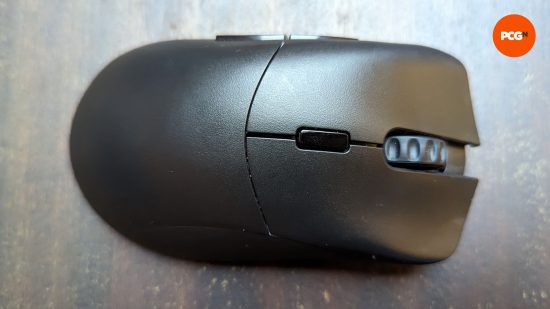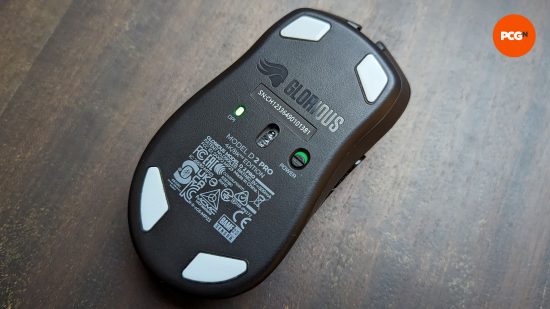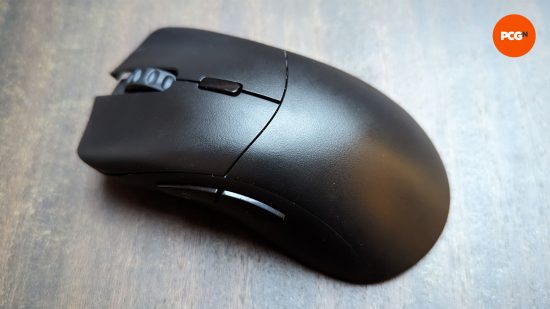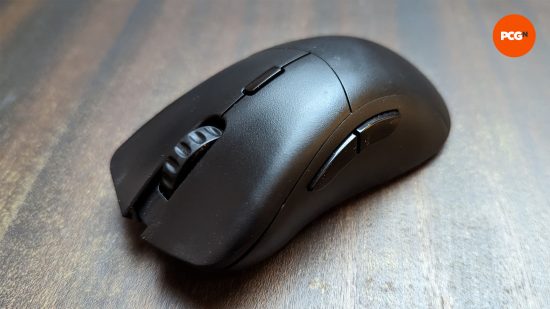Our Verdict
The Glorious Model D2 Pro 4kHz / 8kHz is an excellent competitive gaming mouse, but struggles to justify its price compared to its cheaper sibling.
- Comfy ergonomic shape
- Highly responsive optical switches
- Excellent sensor
- Doesn’t stand out looks-wise
- No Bluetooth connectivity
- Higher polling rates compromise battery life and price
When it comes to gaming mice, Glorious Gaming is probably best-known as an early adopter of the honeycomb hole design, which shaves off weight by cutting hexagonal holes in the mouse’s outer layer of plastic. However, for some reason, it eschewed this structure for its new mouse, the Glorious Gaming Model D2 Pro 4kHz / 8kHz.
Despite lacking the brand recognition of Razer or Corsair, Glorious has produced some great gaming mice over the past few years, like its excellent predecessor, the Model D Wireless. Can the Glorious Model D2 Pro 4kHz / 8kHz live up to its forebear and earn a place on our best gaming mouse guide?
I’ve spent a month testing out this clicker in a variety of games, from competitive FPS like The Finals and Valorant to RPGs like Genshin Impact and Elden Ring, and the new RTS, Warhammer Age of Sigmar – Realms of Ruin, and found that it performs at the very highest level. Read on for our full review analyzing its performance, design, features, and price.
Why you can trust our advice ✔ At PCGamesN, our experts spend hours testing hardware and reviewing games and VPNs. We share honest, unbiased opinions to help you buy the best. Find out how we test.
Glorious Model D2 Pro 4kHz / 8kHz specs
| Sensor | BAMF 2.0 26K Sensor |
| DPI | 26,000 |
| Buttons | 6 |
| Connectivity | 2.4GHz, USB-C |
| Weight | 62g |
Glorious Model D2 Pro 4kHz / 8kHz design
The Glorious Model D2 Pro 4kHz / 8kHz firmly prioritizes function over form. It’s not an unattractive mouse — far from it. Its sleek, ergonomic design looks perfectly at home on my desk, but it doesn’t stand out from the crowd.
There’s a conspicuous absence of RGB, which might bother some. However, I’m happy to leave the flashing lights to keyboards, fans, and the like, and have my mouse concentrate on performance. Something the Glorious Model D2 Pro 4kHz / 8kHz absolutely does.
Back to the design: its asymmetrical shape marks it out as a right-handed mouse, so lefties will have to look elsewhere. Glorious actually released the similar Glorious Model O2 Pro at the same time as this mouse, and it’s slightly lighter with a symmetrical design. That means its shape serves as a good starting point for left-handed folks who otherwise like the look of the D2 Pro, but the O2 Pro does lack side/thumb buttons on both sides so isn’t truly ambidextrous.

On the bottom of the D2 Pro are four teflon feet which rid the base of any unwanted friction. The mouse has six remappable buttons in total: left-click, right-click, scroll wheel, an extra one below the scroll wheel, and two on the left-hand contour for your thumb.
Although this is a pretty standard set-up, Glorious has positioned the buttons perfectly for ease of use. There’s no awkward claw-grip necessary to reach any of the six buttons, they’re all located under where my fingers naturally rest or a tiny movement away. I’d have liked to see an extra button below the scroll wheel like the Razer Cobra Pro has, but that’s just a minor quibble.
The real question with the Glorious Model D2 Pro 4kHz / 8kHz is why Glorious chose not to implement its distinctive honeycomb design for this model. This could have shaved a few grams off the mouse’s 62g frame, taking it to the much-coveted sub-60g mark.
Glorious Model D2 Pro 4kHz / 8kHz features and software
The Glorious Model D2 Pro 4kHz / 8kHz has two connection modes: wired via USB-C and wireless via a 2.4GHz 4kHz wireless receiver. I usually prefer wireless modes when it comes to gaming mice, but this mouse is different. The included USB-C cable is unusually light and flexible, minimizing any hindrance while gaming, and the connector has plastic protuberances on either side which allow it to click securely into place when attached to the mouse, so there’s no chance of it being dislodged.
The main reason, though, is that the vaunted 8kHz polling rate is only available with a wired connection. The wireless receiver grants a maximum of 4kHz. That’s fine for most purposes, of course, but those who swear by a high polling rate and wireless mice will find they can’t satisfy both criteria at once. I must say, the difference between 4kHz and 8kHz is totally imperceptible to me, though.
The lack of Bluetooth connection is a shame but common enough on this type of wireless mouse – it tends to only feature on wireless mice that use AA batteries. It’s definitely worth bearing in mind if you were hoping for a mouse suited to a wider range of uses, including travel, though.
In terms of software, this clicker is supported by Glorious Core. I know what you’re thinking: not another peripheral program! I’m afraid so. It’s not the prettiest or most intuitive interface, but does the trick, and is an unfortunate necessity when mice are all expected to have extensive customization options. On that note, Glorious Core allows you to remap buttons, customize DPI, lift-off distance, debounce preferences, polling rate, motion sync, and a few other trivial settings.
The polling rate is adjustable in small increments from 125Hz to 8kHz, but as discussed, the latter is only achievable in wired mode. Polling rate has a big impact on battery life, something I’ll discuss further in the ‘Performance’ section of this review.
It’s worth noting that updating the mouse’s firmware in Glorious Core is prone to failure for unknown reasons, which can result in the mouse only being operable in wired mode. I never managed to fully troubleshoot this, but found that retrying the firmware update several times fixed the issues. Annoying when it happened, but not the end of the world.
The Glorious Model D2 Pro 4kHz / 8kHz swells its competitive gaming credentials with the addition of optical switches with an impressive 0.2ms response time and 100m click lifespan. This is a clear improvement over its predecessor, the Model D Wireless, which had less-responsive mechanical switches.
Glorious Model D2 Pro 4kHz / 8kHz performance
The Glorious Model D2 Pro 4kHz / 8kHz outstanding gaming performance is driven by its new-and-improved BAMF sensor. The BAMF 2.0 26K sensor enjoys 650 inches per second tracking, 26,000 programmable DPI, and up to 8kHz polling, as mentioned above. Again, this is a clear improvement over the sensor’s first iteration in the Model D Wireless, which had 400IPS, 19,000 DPI, and 1kHz max polling rate.
In my experience, the sensor is flawless. The Glorious Model D2 Pro 4kHz / 8kHz is a capable and trusty companion throughout my gaming adventures, whether I’m blasting away the competition in The Finals, or ordering my troops around the battlefield in Warhammer Age of Sigmar – Realms of Ruin. I never noticed a hint of latency, sluggishness, or any lost inputs.
It’s also very comfortable to use, thanks to smart button placement and optimal weight distribution across the mouse’s body. It obeys my every whim like it’s an extension of my arm. And low-DPI-aimers will be pleased to know the teflon feet allow this mouse to whizz across your desk with minimal effort.

OK, so it performs well, but can it last? I’m pleased to say the Glorious Model D2 Pro 4kHz / 8kHz’s battery is pretty solid. It’s not the best I’ve used, but is capable of running for a few days between charges. Glorious boasts that the mouse has an 80-hour battery life, but the small print clarifies that this is at 1kHz polling rate.
If you’ve forked out extra for the 4kHz / 8kHz version of the Model D2 Pro, you’ll surely want to make the most of this higher polling rate. But that comes at the expense of the mouse’s battery life. I don’t personally find the higher polling rate worth the hit to battery life, so usually went for 1 or 2kHz. But it’s important to note that I’m not a big believer in polling rates above 2kHz anyway, as I can’t personally tell the difference. Still, having the option is handy for pros and discerning gamers with a taste for high polling rates.
Glorious Model D2 Pro 4kHz / 8kHz price
At $129.99 / £119.99, the Glorious Model D2 Pro 4kHz / 8kHz is quite pricey, but still cheaper than a lot of top gaming mice. It’s a fair price I’d say, when you consider most mice that can access 8kHz polling rate are dearer. As mentioned, the premium USB-C bundled with this mouse is excellent, and worth an extra $10 on its own in my opinion.
But we need to talk about the elephant in the room. The non-4kHz / 8kHz version exists, and it’s $30 cheaper, despite boasting a nearly identical feature set to the pricier model. It caps out at 1kHz polling rate, but that suits me just fine.

Glorious Model D2 Pro 4kHz / 8kHz conclusion
The Glorious Model D2 Pro 4kHz / 8kHz is a great mouse for competitive gaming, and usually, it would be an easy sell. Great performance and no unnecessary frippery at a decent price… What’s not to like? Well, the fact that it exists in a world with the standard Glorious Model D2 Pro.
Although it can’t match this mouse’s flashy 8kHz max polling rate, it’s $30 cheaper and 2g lighter. For me, that’s an easy decision. It pains me to say it, because this is a great mouse, but most people should just buy the other version instead.
However, if you’re a real stickler for higher polling rates, you’ll struggle to find a better package than the Glorious Model D2 Pro 4kHz / 8kHz. It really is a great mouse, it’s just hurt by its sibling being even better value.
